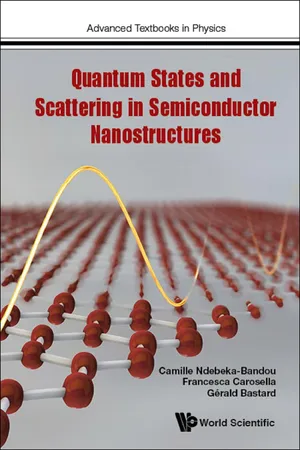
Quantum States and Scattering in Semiconductor Nanostructures
- 448 pages
- English
- ePUB (mobile friendly)
- Available on iOS & Android
Quantum States and Scattering in Semiconductor Nanostructures
About this book
-->
This book is an introduction to quantum states and of their scattering in semiconductor nanostructures. Written with exercises and detailed solutions, it is designed to enable readers to start modelling actual electron states and scattering in nanostructures. It first looks at practical aspects of quantum states and emphasises the variational and perturbation approaches. Following this there is analysis of quasi two-dimensional materials, including discussion of the eigenstates of nanostructures, scattering mechanisms and their numerical results.
Focussing on practical applications, this book moves away from standard discourse on theory and provides students of physics, nanotechnology and materials science with the opportunity to fully understand the electronic properties of nanostructures.
--> Headers: With more than 50 Exercises & Solutions (168 pages)
Contents:
- Practical Quantum Mechanics:
- Schrödinger Equation
- Bound and Extended States
- Approximate Methods
- Landau Quantisation of Electron Motion in Ideal Semiconductor Bulks and Heterostructures
- The Physics of Heterostructures:
- Background on Heterostructures
- Electrons States in Nanostructures
- Beyond the Ideal World
- Screening at the Semi-Classical Approximation
- Results for Static Scatterers
- Results for Electron-Phonon Interaction
- Beyond the Born Approximation
- Exercises
-->
--> Readership: Students of physics, nanoscience and materials science, professionals working with nanomaterials, and researchers. -->
Keywords:Nanostructures;2D Structures;Laser;Carriers;Heterostructures;Quantum Mechanics;Perturbation Theory; Fermi Golden Rule;Screening;Scattering;Impurities;PhononsReview:
"This book teaches how to solve many important problems analytically. 253 pages of well-structured text is complemented by 165 pages of more than 50 exercises. I recommend it to all who seek understanding and insight."
Prof Dieter Bimberg
Technical University of Berlin
0
Frequently asked questions
- Essential is ideal for learners and professionals who enjoy exploring a wide range of subjects. Access the Essential Library with 800,000+ trusted titles and best-sellers across business, personal growth, and the humanities. Includes unlimited reading time and Standard Read Aloud voice.
- Complete: Perfect for advanced learners and researchers needing full, unrestricted access. Unlock 1.4M+ books across hundreds of subjects, including academic and specialized titles. The Complete Plan also includes advanced features like Premium Read Aloud and Research Assistant.
Please note we cannot support devices running on iOS 13 and Android 7 or earlier. Learn more about using the app.
Information
PART I
Practical Quantum Mechanics
Chapter I.1
Schrödinger Equation


































Table of contents
- Cover page
- Title page
- Contents
- Foreword
- About the Authors
- Part I Practical Quantum Mechanics
- Part II The Physics of Heterostructures
- Part III Exercises
- Bibliography
- Index